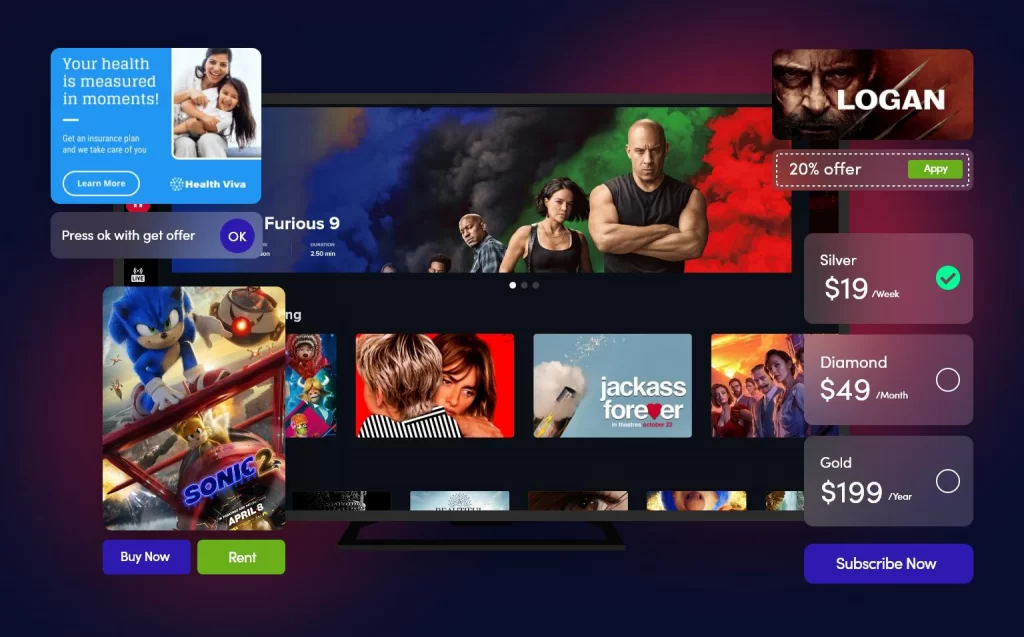The Definitive Guide to Apollo Group Tv
The Definitive Guide to Apollo Group Tv
Blog Article
The Main Principles Of Apollo Group Tv
Table of ContentsThe Main Principles Of Apollo Group Tv How Apollo Group Tv can Save You Time, Stress, and Money.Apollo Group Tv Fundamentals ExplainedApollo Group Tv Fundamentals Explained
In this situation, as opposed to having three-minute industrial places during a 30-minute television program, TV shows may change to one where a customer will certainly be needed to have a monthly subscription, to ensure that they cen view targeted banner ads. This kind of marketing already occurs on the web, and the amount of data tv firms collect allows them to do much the very same.Define the significant trends among the broadcasting and cable networks. Popular radio reveals such as police dramatization Dragnet and western cowboy series Gunsmoke were adapted for tv, and new Television shows were sponsored by single marketers, just as radio programs had actually been.
Today, the tv industry is much more intricate. Programs are funded by numerous marketers; programming is regulated by major media empires; and the 3 major networks no more dominate the airwaves yet instead share their visitors with countless cord channels. Numerous aspects represent these fads within the industry, consisting of technological advancements, government guidelines, and the creation of new networks.

The Definitive Guide to Apollo Group Tv
Established in 1969, (PBS) established out of a report by the Carnegie Compensation on Educational Tv, which analyzed the function of academic, noncommercial tv on society. Public television was additionally intended to provide universal access to television for viewers in country areas or customers who could not afford to pay for private television solutions.
The period in between 1950 and 1970 is traditionally recognized as the. Apart from a tiny section of airtime regulated by public television, the three major networks (called the Big Three) controlled the television industry, jointly representing even more than 95 percent of prime-time viewing. In 1986, Rupert Murdoch, the head of international business Information Corp, launched the Fox network, testing the supremacy of the Big 3.
Targeting young and minority audiences with shows such as Buffy the Vampire Slayer, Moesha, Dawson's Creek, and The Wayans Bros., the new networks wanted to attract terminals away from their old network affiliations. Instead than duplicating the success of Fox, UPN and WB battled to make an influence. Incapable to bring in numerous affiliate terminals, both fledgling networks got to less families than their larger rivals because they were inaccessible in some smaller cities.
This decision paved the way for the growth of cord film networks, adding to the exponential development of cable television in the 1980s and 1990s. apollo group tv app. Further deregulation of cable television in the 1984 Cable Television Communications Policy Act removed constraints on cable television prices, making it possible for drivers to charge what they wanted for wire solutions as long as there worked competitors to the solution (a standard that over 90 percent of all cord markets might satisfy)
Rumored Buzz on Apollo Group Tv

Having actually created the first "superstation," Turner expanded his realm by establishing 24-hour information network CNN in 1980. At the end of the year, 28 national programs solutions were available, and the cord change had begun. Over the following years, the industry went through a duration of rapid growth and appeal, and by 1994 customers could pick from 94 fundamental and 20 premium cable solutions.
Number 9 - https://www.kickstarter.com/profile/apollogtv01/about.16 Boosted competitors from wire networks has actually created a steady decrease in the networks' audience scores. Throughout the 1950s, the expense of producing a solitary television program enhanced as programs became longer and manufacturing prices soared. Sponsorship on network tv shifted from single sponsorship, in which a program was completely sustained and produced by one marketer, to numerous sponsorship, in which marketers purchased 1- or 2-minute places on the show
Choose one of the Big Four networks and publish out its once a week programming timetable. Watch the network's prime-time programs over the course of a week, noting the target demographic for each show.
More About Apollo Group Tv

Straight TV, usually referred to as typical broadcast TV, incorporates cable television and satellite tv. It's called "linear" since content follows a fixed shows schedule, unlike on-demand material which the specific audience makes a decision to watch based on their very own choices and schedule. So, when you ask, "What is direct TV?", think about it as the traditional way of seeing television that has actually been around for decades.
Report this page